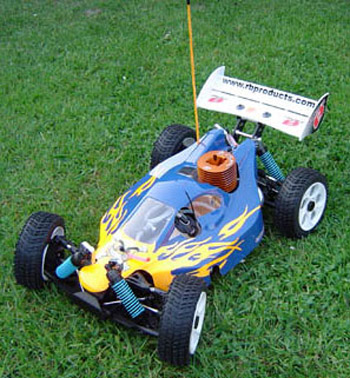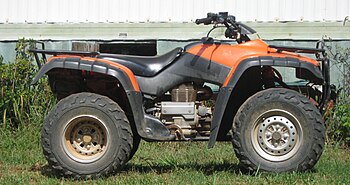If someone is interested in radio controlled hobbies, they almost always start with a car. Unlike a boat or a plane, cars usually won’t be completely destroyed if they fail. It is very easy to make a basic radio controlled car, but as you do it you will discover that there is a huge amount of knowledge that can be gained. As you gain this knowledge, you can start to use advanced techniques to create cars that are stronger, faster, or more efficient than your previous ones. You can throw one together in a few minutes, or you can spend months creating an amazing car with superb speed and handling. The amount of effort you put into it is entirely up to you.
 |
| Hyper 8 Radio Controlled Racing buggy. (Photo credit: Wikipedia) |
If you are just starting with radio controlled hobbies, it is probably wise to just buy a pre-made radio controlled car. You can buy these in toy shops almost anywhere. It may be slow and clumsy, and it may not satisfy your technological urges, but it is a good place to start. Play with it for a couple of days, and then take it apart. Look at the way the motors are connected to the wheels, and look at the general architecture of the car. After you understand it all, you will have much better luck when you start to build your own. You may even be able to use a few parts, such as the body of the car or the radio equipment. The motors will probably not be as strong as you would like.
After you have gained this essential basic understanding of the way that radio controlled cars work, you can start on whatever you want your next project to be. For most people, their goal is to build a model car from wood or plastic, install the electrical components, paint it, apply decals, and basically get it looking as good and performing as good as possible. Others may want to build an incredibly fast remote-controlled car to show off to friends. No matter what you want to do, you will only be able to achieve it if you take it one step at a time and learn everything there is to know about remotely controlled hobbies.
Many different resources can help you out along your way to becoming an expert in radio controlled hobbies. You will probably be spending a lot of time researching all of the different information that you need. You can find it all over the internet, including many different tutorials. For more specific questions, you can go to community groups and forums. This is where people from all over the world gather together on the internet to discuss their hobby, support each other, and brag about their latest accomplishments. Usually, they are very welcoming to newcomers, especially if you are very clear and polite in asking your question.
Radio controlled cars don’t have to be without competition. If you want to put your car up against those of other enthusiasts, you can find many different races and exhibitions around the world. Just do a quick internet search, and find out what the nearest option is. You might have to take a weekend trip, but it will be worth it to be around those who are as passionate as you about what you are doing. These meetings may include races or just a good old convention to share tips and tricks with other radio hobbyists. You would be surprised at the large amount of information that you can learn from the people who go to these events.
cars don’t have to be without competition. If you want to put your car up against those of other enthusiasts, you can find many different races and exhibitions around the world. Just do a quick internet search, and find out what the nearest option is. You might have to take a weekend trip, but it will be worth it to be around those who are as passionate as you about what you are doing. These meetings may include races or just a good old convention to share tips and tricks with other radio hobbyists. You would be surprised at the large amount of information that you can learn from the people who go to these events.
Starting a new hobby may be daunting at first since there is a wealth of information that you probably know nothing about. However, if you just get started with the basics and use all of your resources that are at your disposal, you will be able to succeed.





